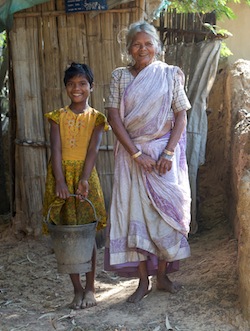
Ursila Bek and her grandaughter Neha Toppo stand beside the new family latrine in the village of Totambi in India’s Ranchi District. (UNICEF India Tom Pietrasik 2009)
The Numi toilet, an opulent throne produced by the bathroom fixtures company Kohler, will raise its heated seat automatically as you approach. It features two flush settings—“flush-eco” and “flush-full”—and doubles as a bidet, spraying warm water and hot air on users. The toilet also has a built-in FM radio, stereo speakers, and a jack for plugging in an MP3 player. Oh, and it costs $6,400.
For the average American, the Numi is an impossible extravagance. But for 1.1 billion people in the developing world, a flush toilet—any kind of toilet—is an unimaginable luxury. The toilet-less masses, who live mainly in rural areas of sub-Saharan Africa and southern Asia, are forced to practice “open defecation” in fields, forests, rivers or other open spaces. Fecal contamination of rivers can contaminate drinking water, and this helps contribute to 1.5 million deaths from diarrhea in children under five every year.
Lack of toilets not only helps spread disease, but it also impedes girls’ education: with no place to change and dispose of sanitary pads, many girls in Africa drop out of school during their menstrual periods—up to one in 10 of all schoolgirls, according to the United Nations Children’s Fund (UNICEF). Some girls leave school permanently when they begin menstruating. For women, the scarcity of toilets can leave them vulnerable to sexual predators. In India’s Bihar State—where 85 percent of rural households have no access to a toilet—most cases of rape occur when women and girls go out to defecate in the open, according to police, who reported 870 rape cases in Bihar in 2012.
Progress is being made, however. According to the United Nations, 1.9 billion people “gained access to a latrine, flush toilet, or other improved sanitation facility” between 1990 and 2011. In Nepal, the government has withheld social benefits, such as stipends for the elderly and access to schools, from families without toilets, with the result that some elderly villagers have built them for the first time in their lives and can “close the door and defecate now without fear.” In May 2013, North Tarawa in Kiribati became the first island in the Pacific where everyone had access to a toilet. In India, where nearly half of the population of 1.2 billion people have no toilets, children receive mandatory hygiene lessons in school, learning that flies can carry viruses and bacteria from feces back to their food. Also, the country’s “No Toilet, No Bride” campaign encourages families to stipulate an unusual precondition for marriage: the groom must provide a toilet in the new couple’s home.
The cost of a porcelain toilet in stores across India? Less than $5.

